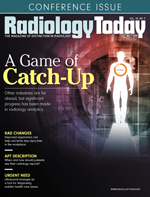 Imaging Informatics: There’s an App for That
Imaging Informatics: There’s an App for That
By Veronika Vartanova
Radiology Today
Vol. 20 No. 7 P. 6
Despite medical imaging being a noninvasive procedure, many patients develop anxiety prior to and during MRI, CT, or other types of scanning. According to a recent survey, about one-half of patients get anxious or even distressed prior to an examination, and the reasons vary.
Some individuals are uneasy at the thought of laying down in a confined space, while possibly receiving IV administration of a contrast agent. Some are uncomfortable with lying still for up to 60 minutes and hearing loud noises. Others are wary of the effect that the large MRI magnet or radiation exposure from the CT scanner may have on them. Additionally, many patients are concerned about their examination results.
Patients may have an array of anxiety triggers related to undergoing a medical imaging procedure. If not addressed properly and in a timely manner, patients’ concerns may reduce their compliance with the instructions from the health specialists, affecting the course and results of the examination. Patients who suffer from panic attacks may need to be sedated for the course of the examination.
To ensure patients’ understanding of the forthcoming procedure and promote their confidence, health specialists can initiate preliminary consultations and educate the individuals about each step of the process. However, because they work with MRI and CT devices daily, radiologists and radiologic technologists may fail to cover all of the necessary details to allay possible patient concerns.
Therefore, mobile health (mHealth) vendors, doctors, and regulators collaborated and used technology to assist health specialists in familiarizing patients with imaging procedures in an engaging way. From explaining anatomy to breaking down the radiation exposure topic, there are mHealth applications to assist providers every step of the way.
Steps Toward Clarity
The primary step in the patient’s education about an upcoming procedure can be familiarizing them with the area of examination. Health specialists can show a patient the organ in question in 3D and visualize the slicing process, explaining what the radiologist will see and search for on the image. One mHealth app that facilitates this type of education is the Android-based 3D Atlas. Created with the help of physicians and anatomy experts, the application is a colorful and highly detailed anatomy atlas with extensive learning functions. Although its primary use is assisting medical students and residents in expanding their knowledge, the interactive animations and slicing feature allow the app to be used for educating patients and encouraging them to ask questions about the upcoming examination.
A significant part of patients’ medical imaging-related anxiety stems from poor awareness of what to expect during the procedure. The National Institute of Biomedical Imaging and Bioengineering wanted to address this issue and help inform patients about medical scanning, so they created a dedicated mHealth application with interactive and accessible information about MRI, X-ray, PET/SPECT, CT, and ultrasound modalities. The app offers images and videos to allow health specialists and patients to communicate more effectively when discussing a procedure. Patients can be also introduced to the application for self-learning and then ask questions throughout the consultation.
Patients who undergo multiple imaging procedures associated with radiation exposure, such as CT, PET/SPECT, or X-ray scanning, may worry about the cumulative radiation dose they will receive over the course of the examinations and wonder whether it is worth the potential harm. If not consulted and informed in a timely manner, some patients may object to the examination. They may even feel they are being forced to get an unnecessary procedure or become convinced that they must refuse the procedure.
To avoid misunderstandings, health specialists can use radiation safety mobile applications, such as RADiDOC. These apps are created to explain radiation exposure and dose in simple terms, allowing users to evaluate radiation risk in a few taps. By using such mHealth apps, providers can show a patient the expected one-time exposure from a particular study as well as calculate the cumulative radiation dose that a patient will receive throughout a series of tests. Moreover, RADiDOC offers patients a personal radiation log in case they need to pass through several scanning sessions or image-guided procedures in a short period of time in different settings. This log can be shared with a patient’s primary care provider, allowing for a more informed decision-making process.
A patient’s confidence and calmness are critical for any diagnostic procedure’s success, and medical imaging is no exception. While some patients don’t experience any concerns prior to undergoing MRI or CT scanning, others can become frustrated and uneasy at the thought of it, potentially compromising the examination course and its results. Step-by-step patient education enhanced with technology can demystify medical scanning, reducing anxiety or panic attack episodes in patients. With the help of mobile apps, health specialists can satisfy a patient’s curiosity about their anatomy, clarify a procedure’s purpose and expected outcomes, explain details of medical imaging, and help patients to picture the entire process beforehand.
— Veronika Vartanova is a mobility researcher at Iflexion, a software development company based in Denver. She writes on the latest trends in mobile app development, augmented and virtual reality business integration, and mobile-first digital transformation.

